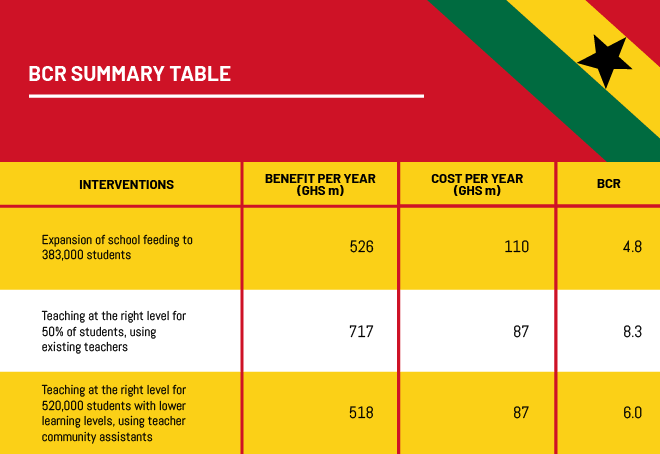Ghana Priorities: Education Quality
Technical Report
The Problem
Ghana has made great strides in education enrolment in the MDG and SDG era, with near universal primary school enrolment and equality between boys and girls (World Bank, 2019). However, as with many developing countries, the quality of education and the extent to which children actually learn remains the critical challenge. A 2016 assessment showed 45% and 30% of 4th graders could not meet minimum standards in mathematics and English respectively (National Education Assessment, 2016).
Intervention 1: Expansion of school feeding to 383,000 students
Overview
This intervention involves scaling up school feeding from 61% of children to 70% of children in basic school or 383,000 students.
Implementation Considerations
We estimate that this would require GHS 80m of government funds per year. Additional costs would be born by households of students and by teachers who would stay longer at school.
Costs and Benefits
Costs
The intervention costs GHS 1.1 per child per day in direct costs paid to caterers and equals GHS 80m per year. Students would spend more time at school, as well as teachers – roughly 20 min per day on average. The total cost of the intervention is GHS 110m per year.
Benefits
The intervention would increase learning levels in students equivalent to an extra half year of junior high school. In the future, students would earn 2.7% more or GHS 2,300 in today’s money if they are exposed to school feeding for two years. Additionaly, there would be benefits to households worth GHS 160 per child from spending less on food. Certain vulnerable sub-groups (girls and the poor) would have even larger benefits including improved nutrition and health.
Intervention 2a: Teaching at the Right Level for 50% of students in grades 1-3
Overview
Teaching at the right level (TaRL) is a pedagogical approach that targets instruction to the learning needs of children. It involves splitting up children into classes based on learning levels, rather than age. This occurs for two hours per day, with the remaining days for normal curriculum teaching. It was developed in India and has been trialled in Ghana in the past.
Implementation Considerations
If the GHS 80m for school feeding per year were instead spent on TaRL – delivered by public school teachers – it could be delivered to 50% students in grades 1-3. Because this would be a new intervention in Ghana, training would be required as well as communication to parents and students. It would be important to make sure children do not feel inferior or less capable after being separated into different classes. Therefore class names for the separated groups should be considered that do not reflect any real or perceived ranking (e.g. names of flowers or animals rather than class A, B or C).
Costs and Benefits
Costs
The cost per child per year for TaRL is GHS 65 and consists mainly of training for teachers, as well as materials and monitoring. Total social costs are GHS 87m per year.
Benefits
The intervention would provide a modest learning boost to all students. If children are exposed to TaRL for three years this learning improvement would be worth 1.5% of earnings over their lives, or roughly GHS 1040 in today’s money. The total social benefits are GHS 717m per year.
Intervention 2b: Teaching at the right level for 520,000 students with low learning levels, using teaching community assistants
Overview
This intervention is the same as the previous one but with a greater focus on weaker students, using teaching community assistants to assist regular teachers. Teacher community assistants are early career youth, looking to gain experience in the workforce.
Implementation Considerations
If the GHS 80m for school feeding expansion were spent on this version of TaRL it could reach 520,000 students in grades 1-3 or enough to almost cover those identified who did not meet minimum learning standards. This intervention would require the identification, training and management of 17,350 teacher community assistants.
Costs and Benefits
Costs
The cost of this intervention is GHS 15 per child per year, with 32% of the cost for teaching community assistants. Total social costs are GHS 87m per year.
Benefits
The intervention woud provide a sizeable learning improvement for weaker students. This would increase their earnings by 2.6% over their life and is worth GHS 1,775 in today’s money. Total social benefits are worth GHS 518m per year.
Key Takeaways
- Teaching at the right level (TaRL) - a pedagogical approach that targets instruction to the learning needs of children – is likely a more efficient use of resoures than school feeding. One variation of TaRL targeted at all children returns 8 cedis for every cedi spent, and another variation targeted at weaker students returns 6 cedis for every cedi spent.
- School feeding returns 5 cedis for every cedi spent. However, school feeding is equity enhancing, providing a greater than expected share of benefits to girls and the poor.
- School feeding is expensive relative to TaRL. For GHS 80m per year the government could provide:
- School feeding to 383,000 students (9 percentage point increase in coverage) or/
- Broad-based TaRL to 1.2m students in grades 1-3 or/
- TaRL for 520,000 weaker students equivalent to ~70% of children who do not meet minimum standards in English and ~50% of children who do not meet minimum standards in mathematics
- Deploying school feeding – a potentially more equity enhancing strategy – versus universal TaRL would leave GHS 200m of benefits ‘on-the-table’ per year.


